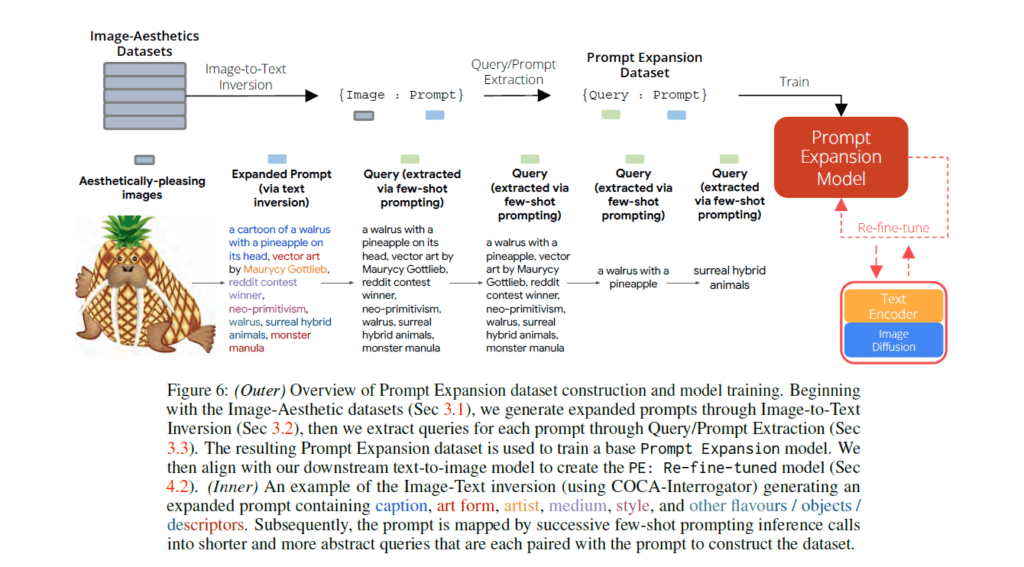The Dawn of Meta-Prompts and the Future of Prompt Engineering
AI has taken massive leaps recently in converting text to images. Systems like DALL-E can render remarkably creative images from imaginative text prompts. However, a new study reveals prompting AI still requires specialized skills – while also providing a glimpse into more advanced “meta-prompts” on the horizon.
Table of contents
Prompt Expansion Framework Points to More Intuitive AI
Researchers from Google, Oxford, and Princeton recently unveiled an AI system for text-to-image generation that points to a shift towards more dynamic AI prompting capabilities. Their “Prompt Expansion Framework” takes a user’s text input and generates a range of expanded prompts optimized to yield more aesthetically pleasing and diverse images.

Early results indicate the system produces images preferred by humans over a leading text-to-image model. This prototype framework represents an evolution in AI’s ability to take initial prompt concepts and enrich them on their own into more sophisticated interpretations.
Key Details on the Prompt Expansion Approach
The researchers’ approach centers on creating a Prompt Expansion dataset linking original text queries to expanded, enriched prompts. The researchers’ dataset was produced by inverting a collection of high-aesthetic images into text captions and descriptive keywords using an “interrogator” technique.

The team then trained a text-to-text transformer model (with one billion parameters) on mapping shorter queries to these more detailed prompts. Interestingly, they found further performance gains by fine-tuning this model based directly on the downstream text-to-image model it would connect to.

Human Evaluation Highlights Benefits
In human evaluations, images generated using the team’s Prompt Expansion framework were preferred by humans for aesthetics 21-24% more often compared to a leading text-to-image model baseline. Humans also rated consistency with the original text queries as equal or better 65-70% of the time.
These early wins point to AI’s increasing capacity to become an active collaborator with users – able to take high-level prompt ideas and build on them to unlock more aesthetic, aligned outputs. This could translate into more accessible and fruitful creative workflows.
Implications: Streamlining Workflows While Retaining Customization
This research highlights dual opportunities for developers and business users of AI. Systems that algorithmically enhance prompts point to more accessible and user-friendly text-to-image experiences requiring less technical skill in “prompt engineering.”
However, the study’s training process also reveals prompt optimization skills remain relevant, especially for customizing AI to specific applications. The researchers hand-tailored an initial dataset of prompt/image pairings – a technique that could allow businesses to tune solutions to their unique needs built on top of the latest generative AI.
Reducing Reliance on Prompt Expertise
A key constraint today in leveraging text-to-image models is the expertise required in carefully crafting prompts. Researchers found that more abstract, general queries still tended to yield repetitive outputs lacking diversity from baseline systems.

But their Prompt Expansion approach demonstrates early progress in AI better handling loosely defined prompts and expanding on them adaptively. This suggests promises for casual users, while still allowing prompt engineering customization were beneficial.
Specialized Prompt Optimization Remains Valuable
However, the training recipe researchers followed also highlights the continuing value of prompt engineering. By manually filtering and tailoring an initial dataset linking texts to quality images, they developed a springboard for the AI to learn prompt enhancement itself.
By applying similar techniques, developers could optimize solutions by leveraging meta-prompt innovations to specific business objectives. This allows blending general advancements with specialized fine-tuning – key for customized enterprise applications.
The Future: Blending Meta-Prompts and Specialized Engineering
This paper crystallizes the transition underway in text-to-image AI. We see glimmers of more intuitive “meta-prompts” that hint at systems rapidly improving in taking basic prompt concepts and running free with them creatively.
Yet prompt engineering is still valuable for customizing these innovative algorithms past their default capabilities. The researchers’ approach itself depended deeply on manual prompt optimization to yield gains.
Expanding Access While Allowing Customization
AI’s increasing meta-prompt capacities points to streamlining text-to-image workflows requiring less niche expertise – expanding access to these generative tools significantly. However, developers maintaining skills in optimizing prompts will remain crucial for molding these innovations to specific goals.
As text-to-image models continue rapidly evolving, we enter an era blending expanding creative firepower with targeted specialization was helpful.
The path forward is leveraging these exponential generative advancements while allowing ample room for customization. With the right fusion of ever-improving meta-prompt and prompt engineering specialization, the possibilities for business innovation and efficient creative flows are tremendously exciting.






